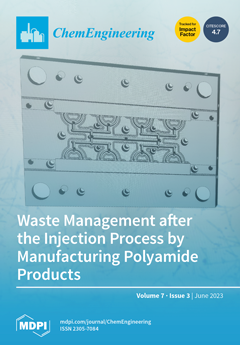Lead is a highly toxic heavy metal that creates a water pollutant. It can be released from industrial processes, agricultural chemistry, and community wastes, affecting creatures and human health even at a low concentration. As a result, it is advised that lead be
[...] Read more.
Lead is a highly toxic heavy metal that creates a water pollutant. It can be released from industrial processes, agricultural chemistry, and community wastes, affecting creatures and human health even at a low concentration. As a result, it is advised that lead be removed before releasing wastewater into the environment. This study synthesized three chitosan bead materials from shrimp shell wastes which were chitosan powder beads (CB), chitosan powder mixed with goethite beads (CFB), and chitosan powder beads coated with goethite (CBF) for removing lead in an aqueous solution. Their surface area, pore volumes, and pore sizes were explored according to Brunauer– Emmett–Teller, and their crystalline formations were investigated using an X-ray diffractometer. Their surface structures were studied using field emission scanning electron microscopy and a focus ion beam, and their chemical compositions were determined using an energy dispersive X-ray spectrometer. Their chemical functional groups were identified via Fourier-transform infrared spectroscopy. In addition, batch experiments were conducted to investigate the effects of several factors on removing lead, and the adsorption isotherm and kinetics were also investigated for determining their adsorption pattern and mechanism. In addition, the desorption experiments were studied to confirm their possible material reusability. The CBF demonstrated the highest surface area and smallest pore size compared with the other materials. In addition, the pore sizes of the CFB and CBF were micropores, whereas those of the CB were mesopores. All materials were semicrystalline structures, and the specific goethite peaks were observed in the CFB and CBF. All materials had spherical shapes with heterogeneous surfaces. Six chemical components of O, C, Ca, N, Cl, and Na were discovered in all materials, and Fe was only found in the CFB and CBF because of the addition of goethite. Five main chemical functional groups of N–H, O–H, C–H, C–O, and –COOH were found in all materials. The optimum conditions of the CB, CFB, and CBF for removing lead were 0.5 g, 16 h, pH 5, 0.5 g, 16 h, pH 5, and 0.4 g, 14 h, pH 5, respectively. The results of the batch experiments demonstrated that the CB, CFB, and CBF were high-efficiency adsorbents for removing lead in solution by more than 95%, whereby the CBF showed the highest lead removal of 99%. The Freundlich isotherm model and pseudo-second-order kinetic model helped to well explain their adsorption pattern and mechanism. The maximum lead adsorption capacities of the CB, CFB, and CBF were 322.58, 333.33, and 344.83 mg/g, respectively. Furthermore, all chitosan materials can be reused for more than three cycles with high lead removal by more than 94%; so, they are potential materials for application in industrial applications.
Full article





